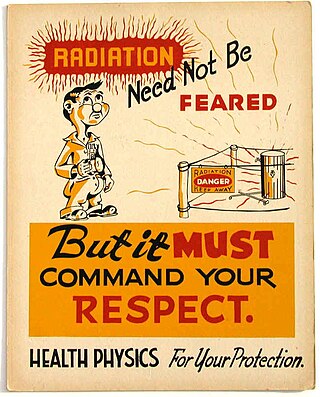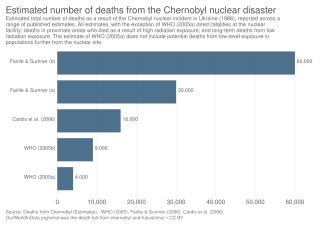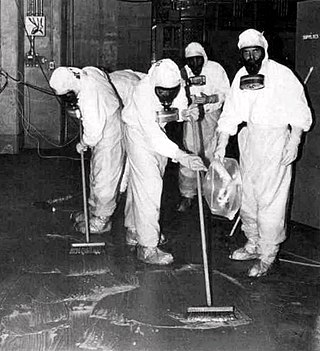Related Research Articles

Sellafield, formerly known as Windscale, is a large multi-function nuclear site close to Seascale on the coast of Cumbria, England. As of August 2022, primary activities are nuclear waste processing and storage and nuclear decommissioning. Former activities included nuclear power generation from 1956 to 2003, and nuclear fuel reprocessing from 1952 to 2022.
Radiation protection, also known as radiological protection, is defined by the International Atomic Energy Agency (IAEA) as "The protection of people from harmful effects of exposure to ionizing radiation, and the means for achieving this". Exposure can be from a source of radiation external to the human body or due to internal irradiation caused by the ingestion of radioactive contamination.

A nuclear and radiation accident is defined by the International Atomic Energy Agency (IAEA) as "an event that has led to significant consequences to people, the environment or the facility." Examples include lethal effects to individuals, large radioactivity release to the environment, or a reactor core melt. The prime example of a "major nuclear accident" is one in which a reactor core is damaged and significant amounts of radioactive isotopes are released, such as in the Chernobyl disaster in 1986 and Fukushima nuclear disaster in 2011.

Health physics, also referred to as the science of radiation protection, is the profession devoted to protecting people and their environment from potential radiation hazards, while making it possible to enjoy the beneficial uses of radiation. Health physicists normally require a four-year bachelor’s degree and qualifying experience that demonstrates a professional knowledge of the theory and application of radiation protection principles and closely related sciences. Health physicists principally work at facilities where radionuclides or other sources of ionizing radiation are used or produced; these include research, industry, education, medical facilities, nuclear power, military, environmental protection, enforcement of government regulations, and decontamination and decommissioning—the combination of education and experience for health physicists depends on the specific field in which the health physicist is engaged.

Radioactive contamination, also called radiological pollution, is the deposition of, or presence of radioactive substances on surfaces or within solids, liquids, or gases, where their presence is unintended or undesirable.
The National Radiological Protection Board (NRPB) was a public authority in the UK created by the Radiological Protection Act 1970. Its statutory functions were to conduct research on radiological protection and provide advice and information on the subject to Government Departments and others. It was also authorized to provide technical services and charge for them. Originally NRPB dealt only with ionizing radiation, but its functions were extended in 1974 to non-ionizing radiation.

Iodine-131 is an important radioisotope of iodine discovered by Glenn Seaborg and John Livingood in 1938 at the University of California, Berkeley. It has a radioactive decay half-life of about eight days. It is associated with nuclear energy, medical diagnostic and treatment procedures, and natural gas production. It also plays a major role as a radioactive isotope present in nuclear fission products, and was a significant contributor to the health hazards from open-air atomic bomb testing in the 1950s, and from the Chernobyl disaster, as well as being a large fraction of the contamination hazard in the first weeks in the Fukushima nuclear crisis. This is because 131I is a major fission product of uranium and plutonium, comprising nearly 3% of the total products of fission. See fission product yield for a comparison with other radioactive fission products. 131I is also a major fission product of uranium-233, produced from thorium.

The Chernobyl disaster began on 26 April 1986 with the explosion of the No. 4 reactor of the Chernobyl Nuclear Power Plant near the city of Pripyat in northern Ukraine, near the Belarus border in the Soviet Union. It is one of only two nuclear energy accidents rated at the maximum severity on the International Nuclear Event Scale, the other being the 2011 Fukushima nuclear accident. The response involved more than 500,000 personnel and cost an estimated 18 billion roubles—around US$68 billion in 2019. It remains the worst nuclear disaster in history, and the costliest disaster in human history, with an estimated cost of US$700 billion.

A hot particle is a microscopic piece of radioactive material that can become lodged in living tissue and deliver a concentrated dose of radiation to a small area. A generally accepted theory proposes that hot particles within the body are vastly more dangerous than external emitters delivering the same dose of radiation in a diffused manner. Other researchers claim that there is little or no difference in risk between internal and external emitters, maintaining that individuals will likely continue to accumulate radiation dose from internal sources even after being removed from the original hazard and properly decontaminated, regardless of the relative danger from an internally sourced radiation dose compared to an equivalent externally sourced radiation dose.

Radiophobia is an irrational or excessive fear of ionizing radiation, leading to overestimating the health risks of radiation compared to other risks. It can impede rational decision-making and contribute to counter-productive behavior and policies. Radiophobia is primarily a social phenomenon as opposed to a purely psychological dynamic. The term is also used to describe the opposition to the use of nuclear technology arising from concerns disproportionately greater than actual risks would merit.

The 1986 Chernobyl disaster triggered the release of radioactive contamination into the atmosphere in the form of both particulate and gaseous radioisotopes. As of 2024, it was the world's largest known release of radioactivity into the environment.

Nuclear safety is defined by the International Atomic Energy Agency (IAEA) as "The achievement of proper operating conditions, prevention of accidents or mitigation of accident consequences, resulting in protection of workers, the public and the environment from undue radiation hazards". The IAEA defines nuclear security as "The prevention and detection of and response to, theft, sabotage, unauthorized access, illegal transfer or other malicious acts involving nuclear materials, other radioactive substances or their associated facilities".

The TORCH report was a health impacts report requested by the European Greens in 2006, for the twentieth anniversary of the Chernobyl disaster, in reply to the 2006 report of the Chernobyl Forum which was criticized by some advocacy organizations opposed to nuclear energy such as Greenpeace.

Nuclear power has various environmental impacts, both positive and negative, including the construction and operation of the plant, the nuclear fuel cycle, and the effects of nuclear accidents. Nuclear power plants do not burn fossil fuels and so do not directly emit carbon dioxide. The carbon dioxide emitted during mining, enrichment, fabrication and transport of fuel is small when compared with the carbon dioxide emitted by fossil fuels of similar energy yield, however, these plants still produce other environmentally damaging wastes. Nuclear energy and renewable energy have reduced environmental costs by decreasing CO2 emissions resulting from energy consumption.

Christopher Busby is a British scientist primarily studying the health effects of internal ionising radiation. Busby is a director of Green Audit Limited, a private company, and scientific advisor to the Low Level Radiation Campaign (LLRC).

Chernobyl: Consequences of the Catastrophe for People and the Environment is a translation of a 2007 Russian publication by Alexey V. Yablokov, Vassily B. Nesterenko, and Alexey V. Nesterenko, edited by Janette D. Sherman-Nevinger, and originally published by the New York Academy of Sciences in 2009 in their Annals of the New York Academy of Sciences series.
The committed dose in radiological protection is a measure of the stochastic health risk due to an intake of radioactive material into the human body. Stochastic in this context is defined as the probability of cancer induction and genetic damage, due to low levels of radiation. The SI unit of measure is the sievert.
Exposure to ionizing radiation is known to increase the future incidence of cancer, particularly leukemia. The mechanism by which this occurs is well understood, but quantitative models predicting the level of risk remain controversial. The most widely accepted model posits that the incidence of cancers due to ionizing radiation increases linearly with effective radiation dose at a rate of 5.5% per sievert; if correct, natural background radiation is the most hazardous source of radiation to general public health, followed by medical imaging as a close second. Additionally, the vast majority of non-invasive cancers are non-melanoma skin cancers caused by ultraviolet radiation. Non-ionizing radio frequency radiation from mobile phones, electric power transmission, and other similar sources have been investigated as a possible carcinogen by the WHO's International Agency for Research on Cancer, but to date, no evidence of this has been observed.

Nuclear labor issues exist within the international nuclear power industry and the nuclear weapons production sector worldwide, impacting upon the lives and health of laborers, itinerant workers and their families.
References
- ↑ Smith, Kirk R.; Frumkin, Howard; Balakrishnan, Kalpana; Butler, Colin D.; Chafe, Zoë A.; Fairlie, Ian; Kinney, Patrick; Kjellstrom, Tord; Mauzerall, Denise L.; McKone, Thomas E.; McMichael, Anthony J.; Schneider, Mycle (18 March 2013). "Energy and Human Health". Annual Review of Public Health. 34 (1): 159–188. doi:10.1146/annurev-publhealth-031912-114404. hdl: 1885/29543 . ISSN 0163-7525 . Retrieved 18 February 2022.
- 1 2 Dr Ian Fairlie publications.
- 1 2 International Physicians for the Prevention of Nuclear War.
- 1 2 Nobel Peace Laureates 1985. Nobel Media AB 2014.
- 1 2 Nuclear Energy Conference 2016 speakers
- ↑ If You Love This Planet : Dr. Ian Fairlie is interviewed by Helen Caldicott.